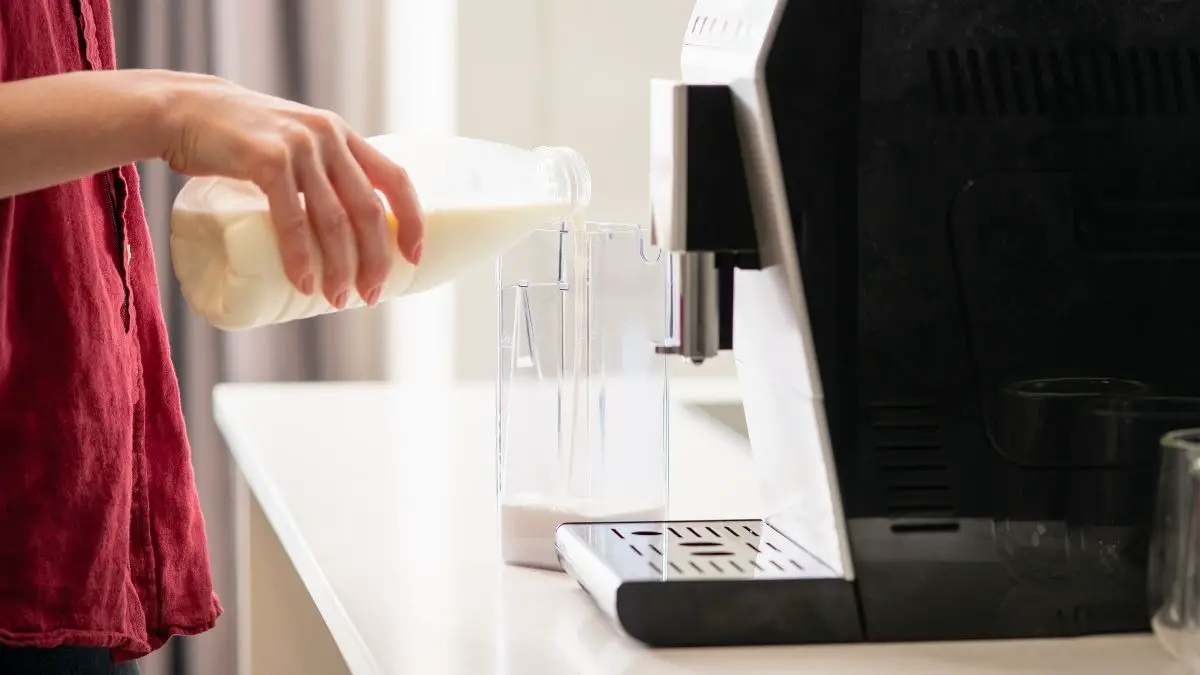A coffee maker is a useful kitchen item that makes it easier to make coffee instantly. Many individuals believe that using milk rather than water is common and faster when making coffee with coffee machines.
For various reasons, you must not use milk rather than water in your coffee machine. Milk contains proteins that once brewed, provide an ideal growing habitat for bacteria. It also thickens at extreme heat, which might also jam or even destroy your coffee machine.
Furthermore, cleaning the coffee machine after making coffee with milk is difficult. The leftover milk would remain within the device, leading every coffee you make afterward to taste awful.
Continue reading to find out why you should really not put milk in the coffee maker and what options you may use to have your coffee less bitter and milkier.
Why You Shouldn’t Put Milk In Your Coffee Maker
It’s obviously easier to add milk directly to your coffee machine than to heat milk in a different container. It will also save you from having to do more dishes.
You can technically put the milk inside a coffee machine. However, just because you can put milk, doesn’t really imply you should. There’s an explanation why most of the coffee machines have specific guidelines stating that milk must not be placed inside the water tank.
It Will Affect The Taste Of Your Coffee
Coffee machines are especially intended to boil water to create brewed coffee. When you substitute milk for water, its quality will deteriorate, and you’ll most probably wind up sipping terrible coffee.
And besides, milk does not really taste all that wonderful whenever it’s overheated.
Additionally, because your machine will not be able to extract everything from the coffee like it does using water, your milk can overshadow the flavor of the coffee. As an outcome, instead of coffee with a touch of milk, you’ll be stuck getting milk with just a bit of coffee.
Bacteria Might Grow Within The Machine
One reason to not use the milk in lieu of water would be that mold and germs may grow within the coffee maker.
Mold can develop on whatever the milk has come into contact with throughout the coffee-making procedure. This makes the device unhygienic, and it will most probably make all coffees you produce in the future be terrible.
No matter how well you clean the coffee maker, the milk deposit would always remain, which could only be removed by totally reengaging the machine’s components.
Falling ill just because of a cup of coffee, regardless of how rich and wonderful is clearly not worth the price. Furthermore, it will take you a long time to thoroughly clean the machine compared to using a different kettle to boil your milk.
It Can Clog Your Machine
As previously stated, bacteria could grow if water is replaced with milk because the remaining milk inside the machine can deteriorate. Milk includes proteins that aren’t found in water, and when they accumulate, they congeal and clog your machine. This not only creates unneeded stress, but it could also necessitate the purchase of a new coffee machine.
It Reduces The Nutrients Of Milk
Milk has a lot of vitamin B, calcium, and other minerals that are vital to the body. However, boiling milk or overheating it, such as putting milk inside a coffee machine, might induce vitamin depletion.
Various studies have demonstrated that heat has a direct effect on vitamin B levels. Boiling milk, for instance, has been shown in certain studies to lower vitamin B levels by roughly 25%, with the others claiming that the proportion might be higher. The calcium content follows the same pattern. As a result, attempting to boil or reheat the milk might reduce the calcium content.
As a result, while brewing coffee using a machine, you could use water for milk. After that, you may add milk to the coffee to maintain its nutrition.
It Makes It Difficult To Clean The Coffee Maker
Milk has a higher density compared to water and includes proteins and fats that water doesn’t have.
Once you brew with water, you don’t get that deposit. Because water merely evaporates, you don’t need to thoroughly clean the device after each brew.
But, if you put milk in, you must disassemble it all to carefully clean all of the milk leftovers. Because If you don’t, it’ll roast it again after more brew, resulting in difficult blockages and equipment failure. The major issue, though, is that it might create significant health issues.
What To Do Instead?
Rather than pouring milk into the coffee machine, you might brew the coffee the traditional manner, with water, and afterward, add milk to it.
By brewing the coffee in this manner, you may prevent harming the equipment while still getting a smooth and far less sharp taste by adding milk. To get the coffee extra creamy, use much less water just so the coffee becomes stronger as well as the milk has a greater concentration once added to the coffee.
Other Methods For Adding Milk To Coffee
There are many various ways to accomplish the very same effect as adding milk in your coffee maker to produce a cappuccino or latte without destroying your coffee machine.
To make a delightful drink, simply add sugar or cream to normal coffee. However, if you want to make a handmade latte or other sophisticated beverage, there are many techniques to whisk your milk and achieve a similar effect.
First Step: Steam The Milk
If you do not have an espresso machine or another method for steaming milk, you may do that using a microwave or even on the stove.
To microwave milk, follow these steps:
- Microwave it for around 30 seconds inside a glass jar.
- To uniformly disperse the heat, swirl or stir the milk.
- For the next 30 seconds, heat it up.
To make steaming milk using the stove,
- In a medium-sized saucepan, heat the milk.
- Continue to gently swirl the milk till it hits 140 to 160 degrees F.
- Keep a close eye on the temperature with a thermometer.
- If you don’t own a thermometer at home, keep tabs on it till milk begins to warm well all the way around. Perhaps around five minutes.
Second Step: Froth The Milk
To froth the steaming milk, use a frothing whisk. If you have microwaved the milk inside a bin with a cover, you may froth it by shaking the canister rapidly for about 30 seconds.
To froth the milk, you can also use a French press by simply pouring the heated milk through into the beaker and pushing the lever up and down till the milk has foamy bubbles.
You can also use a hand mixer and vigorously stir up the steamed milk till it makes a foam.
Last Step: Pour It And Enjoy Your Hot Cup Of Coffee
You may prepare coffee in either a coffee maker or a French press. Heated milk, on the other hand, may offer a delightful texture and flavor to your coffee.
Frequently Asked Questions
How Can You Remove The Milk From The Coffee Maker?
For those who are used to putting milk to their coffee maker, here’s just a quick technique for cleaning it.
Prepare a half-and-half solution of vinegar and water. You can also use baking soda in place of vinegar. Pour it inside the coffee machine. The acidity can aid in dissolving the milk deposit and cleaning the equipment.
Can You Put Milk In An Espresso Machine?
The coffee makers are all in the same boat with an espresso machine. As a result, the response is also negative. Also, espresso machines brew coffee using water heated to 200°F. However, the heat at which milk curdles is 180°F. As a result, pouring milk into your equipment might cause it to malfunction.
Why Do People Like To Put Milk In Their Coffee?
Putting milk in the coffee is a common practice. Since regular coffee is bitter, it’s not really suitable for everyone. As a result, pouring milk into coffee is an excellent technique to lessen harshness and improve smoothness.
Milk contains vitamins, proteins, and fats. When executed properly, the fat in milk changes the consistency of a coffee to make it richer and finer.
Wrapping Up
While it may appear harmless to use milk rather than water inside a coffee machine, you should avoid doing so.
If you add milk to your coffee maker ever again, carefully disconnect its components and thoroughly clean it. Doing so will not just prevent problems with your equipment but will also be beneficial to your wellness.

